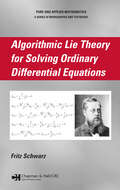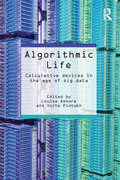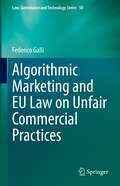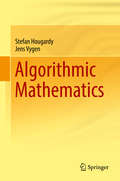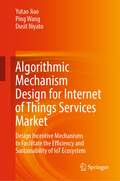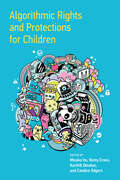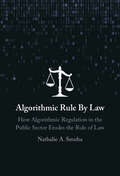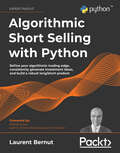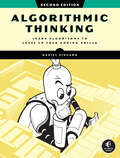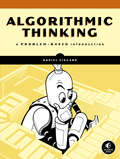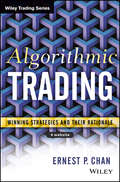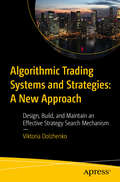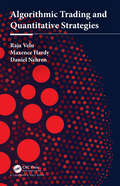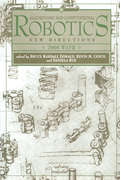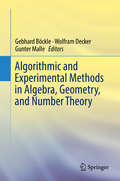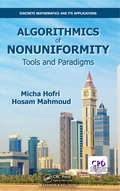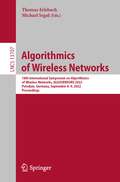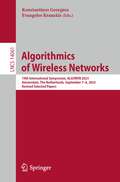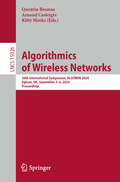- Table View
- List View
Algorithmic Learning in a Random World
by Alexander Gammerman Vladimir Vovk Glenn ShaferThis book is about conformal prediction, an approach to prediction that originated in machine learning in the late 1990s. The main feature of conformal prediction is the principled treatment of the reliability of predictions. The prediction algorithms described — conformal predictors — are provably valid in the sense that they evaluate the reliability of their own predictions in a way that is neither over-pessimistic nor over-optimistic (the latter being especially dangerous). The approach is still flexible enough to incorporate most of the existing powerful methods of machine learning. The book covers both key conformal predictors and the mathematical analysis of their properties. Algorithmic Learning in a Random World contains, in addition to proofs of validity, results about the efficiency of conformal predictors. The only assumption required for validity is that of "randomness" (the prediction algorithm is presented with independent and identically distributed examples); in later chapters, even the assumption of randomness is significantly relaxed. Interesting results about efficiency are established both under randomness and under stronger assumptions. Since publication of the First Edition in 2005 conformal prediction has found numerous applications in medicine and industry, and is becoming a popular machine-learning technique. This Second Edition contains three new chapters. One is about conformal predictive distributions, which are more informative than the set predictions produced by standard conformal predictors. Another is about the efficiency of ways of testing the assumption of randomness based on conformal prediction. The third new chapter harnesses conformal testing procedures for protecting machine-learning algorithms against changes in the distribution of the data. In addition, the existing chapters have been revised, updated, and expanded.
Algorithmic Lie Theory for Solving Ordinary Differential Equations (Chapman & Hall/CRC Pure and Applied Mathematics)
by Fritz SchwarzDespite the fact that Sophus Lie's theory was virtually the only systematic method for solving nonlinear ordinary differential equations (ODEs), it was rarely used for practical problems because of the massive amount of calculations involved. But with the advent of computer algebra programs, it became possible to apply Lie theory to concrete proble
Algorithmic Life: Calculative Devices in the Age of Big Data
by Louise Amoore Volha PiotukhThis book critically explores forms and techniques of calculation that emerge with digital computation, and their implications. The contributors demonstrate that digital calculative devices matter beyond their specific functions as they progressively shape, transform and govern all areas of our life. In particular, it addresses such questions as: How does the drive to make sense of, and productively use, large amounts of diverse data, inform the development of new calculative devices, logics and techniques? How do these devices, logics and techniques affect our capacity to decide and to act? How do mundane elements of our physical and virtual existence become data to be analysed and rearranged in complex ensembles of people and things? In what ways are conventional notions of public and private, individual and population, certainty and probability, rule and exception transformed and what are the consequences? How does the search for ‘hidden’ connections and patterns change our understanding of social relations and associative life? Do contemporary modes of calculation produce new thresholds of calculability and computability, allowing for the improbable or the merely possible to be embraced and acted upon? As contemporary approaches to governing uncertain futures seek to anticipate future events, how are calculation and decision engaged anew? Drawing together different strands of cutting-edge research that is both theoretically sophisticated and empirically rich, this book makes an important contribution to several areas of scholarship, including the emerging social science field of software studies, and will be a vital resource for students and scholars alike.
Algorithmic Marketing and EU Law on Unfair Commercial Practices (Law, Governance and Technology Series #50)
by Federico GalliArtificial Intelligence (AI) systems are increasingly being deployed by marketing entities in connection with consumers’ interactions. Thanks to machine learning (ML) and cognitive computing technologies, businesses can now analyse vast amounts of data on consumers, generate new knowledge, use it to optimize certain processes, and undertake tasks that were previously impossible.Against this background, this book analyses new algorithmic commercial practices, discusses their challenges for consumers, and measures such developments against the current EU legislative framework on consumer protection. The book adopts an interdisciplinary approach, building on empirical findings from AI applications in marketing and theoretical insights from marketing studies, and combining them with normative analysis of privacy and consumer protection in the EU.The content is divided into three parts. The first part analyses the phenomenon of algorithmic marketing practices and reviews the main AI and AI-related technologies used in marketing, e.g. Big data, ML and NLP. The second part describes new commercial practices, including the massive monitoring and profiling of consumers, the personalization of advertising and offers, the exploitation of psychological and emotional insights, and the use of human-like interfaces to trigger emotional responses. The third part provides a comprehensive analysis of current EU consumer protection laws and policies in the field of commercial practices. It focuses on two main legal concepts, their shortcomings, and potential refinements: vulnerability, understood as the conceptual benchmark for protecting consumers from unfair algorithmic practices; manipulation, the substantive legal measure for drawing the line between fair and unfair practices.
Algorithmic Mathematics
by Stefan Hougardy Jens VygenAlgorithms play an increasingly important role in nearly all fields of mathematics. This book allows readers to develop basic mathematical abilities, in particular those concerning the design and analysis of algorithms as well as their implementation. It presents not only fundamental algorithms like the sieve of Eratosthenes, the Euclidean algorithm, sorting algorithms, algorithms on graphs, and Gaussian elimination, but also discusses elementary data structures, basic graph theory, and numerical questions. In addition, it provides an introduction to programming and demonstrates in detail how to implement algorithms in C++. This textbook is suitable for students who are new to the subject and covers a basic mathematical lecture course, complementing traditional courses on analysis and linear algebra. Both authors have given this "Algorithmic Mathematics" course at the University of Bonn several times in recent years.
Algorithmic Mechanism Design for Internet of Things Services Market: Design Incentive Mechanisms to Facilitate the Efficiency and Sustainability of IoT Ecosystem
by Ping Wang Dusit Niyato Yutao JiaoThis book establishes game-theoretical frameworks based on the mechanism design theory and proposes strategy-proof algorithms, to optimally allocate and price the related IoT services, so that the social welfare of IoT ecosystem or the service provider’s revenue can be maximized and the IoT service provision can be sustainable. This book is written by experts based on the recent research results on the interaction between the service providers and users in the IoT system. Since the IoT networks are essentially supported by data, communication, and computing resources, the book focuses on three representative IoT services, including the data analytics services, the cloud/fog computing services for blockchain networks, and the wireless powered data crowdsourcing services. Researchers, scientists, and engineers in the field of resource allocation and service management for future IoT ecosystem can benefit from the book. As such, this book provides valuable insights and practical methods, especially the novel deep learning-based mechanism that can be considered in the emerging IoT technology.
Algorithmic Rights and Protections for Children
by Mizuko Ito, Remy Cross, Karthik Dinakar, and Candice OdgersEssays on the challenges and risks of designing algorithms and platforms for children, with an emphasis on algorithmic justice, learning, and equity.One in three Internet users worldwide is a child, and what children see and experience online is increasingly shaped by algorithms. Though children&’s rights and protections are at the center of debates on digital privacy, safety, and Internet governance, the dominant online platforms have not been constructed with the needs and interests of children in mind. The editors of this volume, Mizuko Ito, Remy Cross, Karthik Dinakar, and Candice Odgers, focus on understanding diverse children&’s evolving relationships with algorithms, digital data, and platforms and offer guidance on how stakeholders can shape these relationships in ways that support children&’s agency and protect them from harm. This book includes essays reporting original research on educational programs in AI relational robots and Scratch programming, on children&’s views on digital privacy and artificial intelligence, and on discourses around educational technologies. Shorter opinion pieces add the perspectives of an instructional designer, a social worker, and parents. The contributing social, behavioral, and computer scientists represent perspectives and contexts that span education, commercial tech platforms, and home settings. They analyze problems and offer solutions that elevate the voices and agency of parents and children. Their essays also build on recent research examining how social media, digital games, and learning technologies reflect and reinforce unequal childhoods.Contributors:Paulo Blikstein, Izidoro Blikstein, Marion Boulicault, Cynthia Breazeal, Michelle Ciccone, Sayamindu Dasgupta, Devin Dillon, Stefania Druga, Jacqueline M. Kory-Westlund, Aviv Y. Landau, Benjamin Mako Hill, Adriana Manago, Siva Mathiyazhagan, Maureen Mauk, Stephanie Nguyen, W. Ian O&’Byrne, Kathleen A. Paciga, Milo Phillips-Brown, Michael Preston, Stephanie M. Reich, Nicholas D. Santer, Allison Stark, Elizabeth Stevens, Kristen Turner, Desmond Upton Patton, Veena Vasudevan, Jason Yip
Algorithmic Rule By Law: How Algorithmic Regulation in the Public Sector Erodes the Rule of Law
by Nathalie A. SmuhaWith the promise of greater efficiency and effectiveness, public authorities have increasingly turned to algorithmic systems to regulate and govern society. In Algorithmic Rule By Law, Nathalie Smuha examines this reliance on algorithmic regulation and shows how it can erode the rule of law. Drawing on extensive research and examples, Smuha argues that outsourcing important administrative decisions to algorithmic systems undermines core principles of democracy. Smuha further demonstrates that this risk is far from hypothetical or one that can be relegated to authoritarian regimes, as many of her examples are drawn from public authorities in liberal democracies that are already making use of algorithmic regulation. Focusing on the European Union, Smuha argues that the EU's digital agenda is misaligned with its aim to protect the rule of law. Novel and timely, this book should be read by anyone interested in the intersection of law, technology, and government.
Algorithmic Short Selling with Python: Refine your algorithmic trading edge, consistently generate investment ideas, and build a robust long/short product
by Michael Covel Laurent BernutLeverage Python source code to revolutionize your short selling strategy and to consistently make profits in bull, bear, and sideways marketsKey FeaturesUnderstand techniques such as trend following, mean reversion, position sizing, and risk management in a short-selling contextImplement Python source code to explore and develop your own investment strategyTest your trading strategies to limit risk and increase profitsBook DescriptionIf you are in the long/short business, learning how to sell short is not a choice. Short selling is the key to raising assets under management. This book will help you demystify and hone the short selling craft, providing Python source code to construct a robust long/short portfolio. It discusses fundamental and advanced trading concepts from the perspective of a veteran short seller. This book will take you on a journey from an idea (“buy bullish stocks, sell bearish ones”) to becoming part of the elite club of long/short hedge fund algorithmic traders. You'll explore key concepts such as trading psychology, trading edge, regime definition, signal processing, position sizing, risk management, and asset allocation, one obstacle at a time. Along the way, you'll will discover simple methods to consistently generate investment ideas, and consider variables that impact returns, volatility, and overall attractiveness of returns. By the end of this book, you'll not only become familiar with some of the most sophisticated concepts in capital markets, but also have Python source code to construct a long/short product that investors are bound to find attractive.What you will learnDevelop the mindset required to win the infinite, complex, random game called the stock marketDemystify short selling in order to generate alpa in bull, bear, and sideways marketsGenerate ideas consistently on both sides of the portfolioImplement Python source code to engineer a statistically robust trading edgeDevelop superior risk management habitsBuild a long/short product that investors will find appealingWho this book is forThis is a book by a practitioner for practitioners. It is designed to benefit a wide range of people, including long/short market participants, quantitative participants, proprietary traders, commodity trading advisors, retail investors (pro retailers, students, and retail quants), and long-only investors.At least 2 years of active trading experience, intermediate-level experience of the Python programming language, and basic mathematical literacy (basic statistics and algebra) are expected.
Algorithmic Thinking, 2nd Edition: Learn Algorithms to Level Up Your Coding Skills
by Daniel ZingaroGet in the game and learn essential computer algorithms by solving competitive programming problems, in the fully revised second edition of the bestselling original. (Still no math required!)Are you hitting a wall with data structures and algorithms? Whether you&’re a student prepping for coding interviews or an independent learner, this book is your essential guide to efficient problem-solving in programming.UNLOCK THE POWER OF DATA STRUCTURES & ALGORITHMS:Learn the intricacies of hash tables, recursion, dynamic programming, trees, graphs, and heaps. Become proficient in choosing and implementing the best solutions for any coding challenge.REAL-WORLD, COMPETITION-PROVEN CODE EXAMPLES:The programs and challenges in this book aren&’t just theoretical—they&’re drawn from real programming competitions. Train with problems that have tested and honed the skills of coders around the world.GET INTERVIEW-READY:Prepare yourself for coding interviews with practice exercises that help you think algorithmically, weigh different solutions, and implement the best choices efficiently.WRITTEN IN C, USEFUL ACROSS LANGUAGES:The code examples are written in C and designed for clarity and accessibility to those familiar with languages like C++, Java, or Python. If you need help with the C code, no problem: We&’ve got recommended reading, too.Algorithmic Thinking is the complete package, providing the solid foundation you need to elevate your coding skills to the next level.
Algorithmic Thinking: A Problem-Based Introduction
by Daniel ZingaroA hands-on, problem-based introduction to building algorithms and data structures to solve problems with a computer.Algorithmic Thinking will teach you how to solve challenging programming problems and design your own algorithms. Daniel Zingaro, a master teacher, draws his examples from world-class programming competitions like USACO and IOI. You'll learn how to classify problems, choose data structures, and identify appropriate algorithms. You'll also learn how your choice of data structure, whether a hash table, heap, or tree, can affect runtime and speed up your algorithms; and how to adopt powerful strategies like recursion, dynamic programming, and binary search to solve challenging problems.Line-by-line breakdowns of the code will teach you how to use algorithms and data structures like: • The breadth-first search algorithm to find the optimal way to play a board game or find the best way to translate a book • Dijkstra's algorithm to determine how many mice can exit a maze or the number of fastest routes between two locations • The union-find data structure to answer questions about connections in a social network or determine who are friends or enemies • The heap data structure to determine the amount of money given away in a promotion • The hash-table data structure to determine whether snowflakes are unique or identify compound words in a dictionaryNOTE: Each problem in this book is available on a programming-judge website. You'll find the site's URL and problem ID in the description. What's better than a free correctness check?
Algorithmic Trading
by Ernie ChanPraise for Algorithmic Trading"Algorithmic Trading is an insightful book on quantitative trading written by a seasoned practitioner. What sets this book apart from many others in the space is the emphasis on real examples as opposed to just theory. Concepts are not only described, they are brought to life with actual trading strategies, which give the reader insight into how and why each strategy was developed, how it was implemented, and even how it was coded. This book is a valuable resource for anyone looking to create their own systematic trading strategies and those involved in manager selection, where the knowledge contained in this book will lead to a more informed and nuanced conversation with managers."-DAREN SMITH, CFA, CAIA, FSA, Managing Director, Manager Selection & Portfolio Construction, University of Toronto Asset Management"Using an excellent selection of mean reversion and momentum strategies, Ernie explains the rationale behind each one, shows how to test it, how to improve it, and discusses implementation issues. His book is a careful, detailed exposition of the scientific method applied to strategy development. For serious retail traders, I know of no other book that provides this range of examples and level of detail. His discussions of how regime changes affect strategies, and of risk management, are invaluable bonuses."-Roger Hunter, Mathematician and Algorithmic Trader
Algorithmic Trading Systems and Strategies: Design, Build, and Maintain an Effective Strategy Search Mechanism
by Viktoria DolzhenkoDesign and develop a complex trading system from idea to operation. Old approaches were based on manually searching for strategy ideas. This book shows you how to create a system that will generate, optimize, and launch profitable strategies into a fully automatic mode. Imagine a system that only requires access to the Internet and electricity from a trader. This book describes the architecture and features of such a system and provides recommendations for further development. Most books cover only the implementation stage and overlook the design and maintenance of these systems. Here, you’ll walk through the entire process of creating a complex, scalable and easily supported system. For example, you’ll design an application based on microservice architecture and learn about development environments. You’ll also examine the advantages of horizontal scaling in the context of creating trading systems. Along the way, you’ll set up Kubernetes, connect the monitoring system. and understand the intricacies of continuous integration and continuous delivery. Testing and identifying only dozens of strategies is a thing of the past. Algorithmic Trading Systems and Strategies: A New Approach shows you how to analyze thousands in the same amount of time.
Algorithmic Trading and Quantitative Strategies
by Raja VeluAlgorithmic Trading and Quantitative Strategies provides an in-depth overview of this growing field with a unique mix of quantitative rigor and practitioner’s hands-on experience. The focus on empirical modeling and practical know-how makes this book a valuable resource for students and professionals. The book starts with the often overlooked context of why and how we trade via a detailed introduction to market structure and quantitative microstructure models. The authors then present the necessary quantitative toolbox including more advanced machine learning models needed to successfully operate in the field. They next discuss the subject of quantitative trading, alpha generation, active portfolio management and more recent topics like news and sentiment analytics. The last main topic of execution algorithms is covered in detail with emphasis on the state of the field and critical topics including the elusive concept of market impact. The book concludes with a discussion on the technology infrastructure necessary to implement algorithmic strategies in large-scale production settings. A git-hub repository includes data-sets and explanatory/exercise Jupyter notebooks. The exercises involve adding the correct code to solve the particular analysis/problem.
Algorithmic and Artificial Intelligence Methods for Protein Bioinformatics
by Min Li Jianxin Wang Yi PanAn in-depth look at the latest research, methods, and applications in the field of protein bioinformaticsThis book presents the latest developments in protein bioinformatics, introducing for the first time cutting-edge research results alongside novel algorithmic and AI methods for the analysis of protein data. In one complete, self-contained volume, Algorithmic and Artificial Intelligence Methods for Protein Bioinformatics addresses key challenges facing both computer scientists and biologists, arming readers with tools and techniques for analyzing and interpreting protein data and solving a variety of biological problems.Featuring a collection of authoritative articles by leaders in the field, this work focuses on the analysis of protein sequences, structures, and interaction networks using both traditional algorithms and AI methods. It also examines, in great detail, data preparation, simulation, experiments, evaluation methods, and applications. Algorithmic and Artificial Intelligence Methods for Protein Bioinformatics:Highlights protein analysis applications such as protein-related drug activity comparisonIncorporates salient case studies illustrating how to apply the methods outlined in the bookTackles the complex relationship between proteins from a systems biology point of viewRelates the topic to other emerging technologies such as data mining and visualizationIncludes many tables and illustrations demonstrating concepts and performance figuresAlgorithmic and Artificial Intelligence Methods for Protein Bioinformatics is an essential reference for bioinformatics specialists in research and industry, and for anyone wishing to better understand the rich field of protein bioinformatics.
Algorithmic and Computational Robotics: New Directions 2000 WAFR
by Daniela Rus Bruce Randall Donald Kevin M. LynchAlgorithms that control the computational processes relating sensors and actuators are indispensable for robot navigation and the perception of the world in which they move. Therefore, a deep understanding of how algorithms work to achieve this control is essential for the development of efficient and usable robots in a broad field of applications.
Algorithmic and Experimental Methods in Algebra, Geometry, and Number Theory
by Wolfram Decker Gebhard Böckle Gunter Malle<P>This book presents state-of-the-art research and survey articles that highlight work done within the Priority Program SPP 1489 “Algorithmic and Experimental Methods in Algebra, Geometry and Number Theory”, which was established and generously supported by the German Research Foundation (DFG) from 2010 to 2016. The goal of the program was to substantially advance algorithmic and experimental methods in the aforementioned disciplines, to combine the different methods where necessary, and to apply them to central questions in theory and practice. Of particular concern was the further development of freely available open source computer algebra systems and their interaction in order to create powerful new computational tools that transcend the boundaries of the individual disciplines involved. <P> The book covers a broad range of topics addressing the design and theoretical foundations, implementation and the successful application of algebraic algorithms in order to solve mathematical research problems. <P> It offers a valuable resource for all researchers, from graduate students through established experts, who are interested in the computational aspects of algebra, geometry, and/or number theory.
Algorithmic and Geometric Aspects of Robotics (Routledge Revivals)
by Jacob T. Schwartz Chee-Keng YapFirst published in 1987, the seven chapters that comprise this book review contemporary work on the geometric side of robotics. The first chapter defines the fundamental goal of robotics in very broad terms and outlines a research agenda each of whose items constitutes a substantial area for further research. The second chapter presents recently developed techniques that have begun to address the geometric side of this research agenda and the third reviews several applied geometric ideas central to contemporary work on the problem of motion planning. The use of Voronoi diagrams, a theme opened in these chapters, is explored further later in the book. The fourth chapter develops a theme in computational geometry having obvious significance for the simplification of practical robotics problems — the approximation or decomposition of complex geometric objects into simple ones. The final chapters treat two examples of a class of geometric ‘reconstruction’ problem that have immediate application to computer-aided geometric design systems.
Algorithmic and High-Frequency Trading
by Álvaro Cartea Sebastian Jaimungal José PenalvaThe design of trading algorithms requires sophisticated mathematical models backed up by reliable data. <P><P> In this textbook, the authors develop models for algorithmic trading in contexts such as executing large orders, market making, targeting VWAP and other schedules, trading pairs or collection of assets, and executing in dark pools. These models are grounded on how the exchanges work, whether the algorithm is trading with better informed traders (adverse selection), and the type of information available to market participants at both ultra-high and low frequency. Algorithmic and High-Frequency Trading is the first book that combines sophisticated mathematical modelling, empirical facts and financial economics, taking the reader from basic ideas to cutting-edge research and practice. If you need to understand how modern electronic markets operate, what information provides a trading edge, and how other market participants may affect the profitability of the algorithms, then this is the book for you.
Algorithmics of Nonuniformity: Tools and Paradigms (Discrete Mathematics and Its Applications)
by Micha Hofri Hosam MahmoudAlgorithmics of Nonuniformity is a solid presentation about the analysis of algorithms, and the data structures that support them. Traditionally, algorithmics have been approached either via a probabilistic view or an analytic approach. The authors adopt both approaches and bring them together to get the best of both worlds and benefit from the advantage of each approach. The text examines algorithms that are designed to handle general data—sort any array, find the median of any numerical set, and identify patterns in any setting. At the same time, it evaluates "average" performance, "typical" behavior, or in mathematical terms, the expectations of the random variables that describe their operations. Many exercises are presented, which are essential since they convey additional material complementing the content of the chapters. For this reason, the solutions are more than mere answers, but explain and expand upon related concepts, and motivate further work by the reader. Highlights: A unique book that merges probability with analysis of algorithms Approaches analysis of algorithms from the angle of uniformity Non-uniformity makes more realistic models of real-life scenarios possible Results can be applied to many applications Includes many exercises of various levels of difficulty About the Authors: Micha Hofri is a Professor of Computer Science, and former department head at Worcester Polytechnic Institute. He holds a Ph.D. of Industrial Engineering (1972), all from Technion, the Israel Institute of Technology. He has 39 publications in Mathematics. Hosam Mahmoud is a Professor at, the Department of Statistics at George Washington University in Washington D.C., where he used to be the former chair. He holds an Ph.D. in Computer Science from Ohio State University. He is on the editorial board of five academic journals.
Algorithmics of Wireless Networks: 18th International Symposium on Algorithmics of Wireless Networks, ALGOSENSORS 2022, Potsdam, Germany, September 8–9, 2022, Proceedings (Lecture Notes in Computer Science #13707)
by Thomas Erlebach Michael SegalThis book constitutes the refereed proceedings of the 18th International Symposium on Algorithmics of Wireless Network, ALGOSENSORS 2022, which took place in Potsdam, Germany in September 2022.The 10 full papers presented in this volume were carefully reviewed and selected from 21 submissions. ALGOSENSORS is an international symposium dedicated to algorithmic aspects of wireless networks.
Algorithmics of Wireless Networks: 19th International Symposium, ALGOWIN 2023, Amsterdam, The Netherlands, September 7–8, 2023, Revised Selected Papers (Lecture Notes in Computer Science #14061)
by Evangelos Kranakis Konstantinos GeorgiouThis book constitutes the refereed proceedings of the 19th International Symposium on Algorithmics of Wireless Networks, ALGOWIN 2023, held in Amsterdam, The Netherlands, during September 7–8, 2023.The 10 full papers included in this book were carefully reviewed and selected from 22 submissions. They were organized in topical sections as follows: design and analysis of algorithms, models of computation and experimental analysis.
Algorithmics of Wireless Networks: 20th International Symposium, ALGOWIN 2024, Egham, UK, September 5–6, 2024, Proceedings (Lecture Notes in Computer Science #15026)
by Kitty Meeks Quentin Bramas Arnaud CasteigtsThis book constitutes the refereed proceedings of the 20th International Symposium on Algorithmics of Wireless Networks, ALGOWIN 2024, held in Egham, UK, in September 2024. The 14 full papers presented here were carefully reviewed and selected from 26 submissions. These papers focus on the Algorithmic aspects of Wireless networks, including the design and analysis of Algorithms, Models of computation and Experimental analysis, involved in various types of computational entities.
Algorithms
by Robert Sedgewick Kevin WayneThis fourth edition of Robert Sedgewick and Kevin Wayne's Algorithms is the leading textbook on algorithms today and is widely used in colleges and universities worldwide. This book surveys the most important computer algorithms currently in use and provides a full treatment of data structures and algorithms for sorting, searching, graph processing, and string processing--including fifty algorithms every programmer should know. In this edition, new Java implementations are written in an accessible modular programming style, where all of the code is exposed to the reader and ready to use. <p><p> The algorithms in this book represent a body of knowledge developed over the last 50 years that has become indispensable, not just for professional programmers and computer science students but for any student with interests in science, mathematics, and engineering, not to mention students who use computation in the liberal arts.
Algorithms and Complexity: 12th International Conference, CIAC 2021, Virtual Event, May 10–12, 2021, Proceedings (Lecture Notes in Computer Science #12701)
by Tiziana Calamoneri Federico CoròThis book constitutes the refereed conference proceedings of the 12th International Conference on Algorithms and Complexity, CIAC 2019, held as a virtual event, in May 2021. The 28 full papers presented together with one invited lecture and 2 two abstracts of invited lectures were carefully reviewed and selected from 78 submissions. The International Conference on Algorithms and Complexity is intended to provide a forum for researchers working in all aspects of computational complexity and the use, design, analysis and experimentation of efficient algorithms and data structures. The papers present original research in the theory and applications of algorithms and computational complexity.Due to the Corona pandemic the conference was held virtually.

